
Just as we wondered if the Orpington chicken could get any lovelier, she went and treated herself to a pretty, purple rinse!
Orpington chickens are deservedly popular with backyard chicken keepers. There are lots of varieties of Orpington to decorate your yard with, and the lavender is the newest addition to the breed. She’s the designer Orpington option! She’s rare, hard to get hold of, hard to replicate, and oh-so beautiful!
Orpington chickens are large, loveable, fluffy chickens with lots of cuddle-worthy, loose-knit feathers. They’re one of the friendliest chickens in town and they’re productive layers with hens laying 200-280 large brown eggs a year. I’m always in ore of the Orpington chicken!
The Lavender Orpington? Well, she has it all plus that quirky purple plumage that makes her so desirable.
Lavender Orpingtons are pretty, unique, friendly, easy to care for, and productive. So, why on Earth aren’t there more of them?
While these lilac-colored lovelies make the perfect poultry pets, they’re still hard to find because they’re a bit of a challenge for breeders. I’ll egg-splain shortly.
“Lavender Orpington Chickens are a true beauty and rarity. Lavender, also known as “self-blue” are not like your typical blue chickens. Lavender Orpingtons will breed true and all of the offspring will be the Lavender color.”(The MeyerHatchery)
There’s always more to chickens than meets the eye. So, whilst I know that you’ll be fixed on this beautiful breed by the time you’ve read this (and seen the baby pictures) never commit to a chick before you’ve done your research.
Chickenpedia is a fast, fun, and frugal way to learn all you need to know about keeping chickens before you buy. Plus, you’ll grab a lifetime of support for all the little challenges they throw your way, which they will!
MEET THE LOVELY LAVENDER ORPINGTON
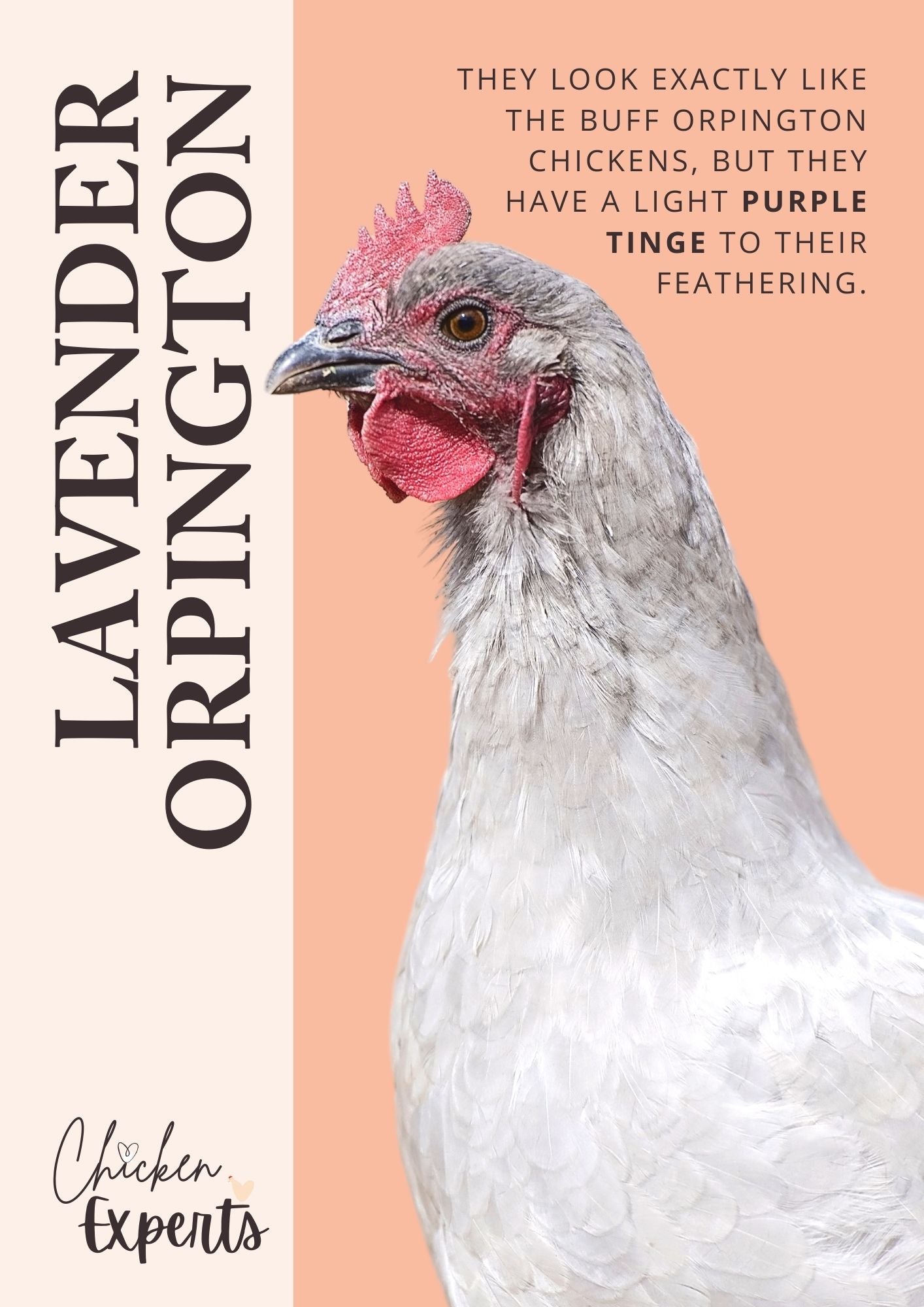
What do Lavender Orpingtons Look Like?
Lavender Orpingtons look eggs-actly like the most popular Buff variety of Orpington, but they have a light purple tinge to their feathering. They’re not bright purple, which would just look silly, but they have light-colored feathers with an all-over pearl-like silvery-lilac tint. For the blondes out there: she looks like she’s just used a purple toner shampoo. You’ll know eggs-actly the shade I mean.
Lavender Orpingtons are large and sturdy-looking chickens that sit close to the ground. They have an arched, broad back and quite a stubby tail. Orpingtons look broader than they are thanks to their dense plumage of loose-knit feathers.
Lavender Orpingtons have dark grey, or slate-colored legs which are usually clean. Some strains might have a few stray feathers on their legs – we’ve all been there – but it’s not acceptable if you’re wanting to show them.
They have a single, five-pointed bright red comb, red wattles, and red earlobes which all pop against their light lavender feathers. They have beautiful bay-red eyes and their beaks are dark horn colored.
They’re just so pretty! 😍
How Big are Lavender Orpingtons?
Lavender Orpington hens weigh around 8 lbs as adults and 7 lbs as pullets, while roosters are 10 lbs as adults and 8.5 lbs as cockerels. Lavender Orpingtons look heavier than they are thanks to their plumped-up purple plumage, but they’re still quite large ladies and gents.

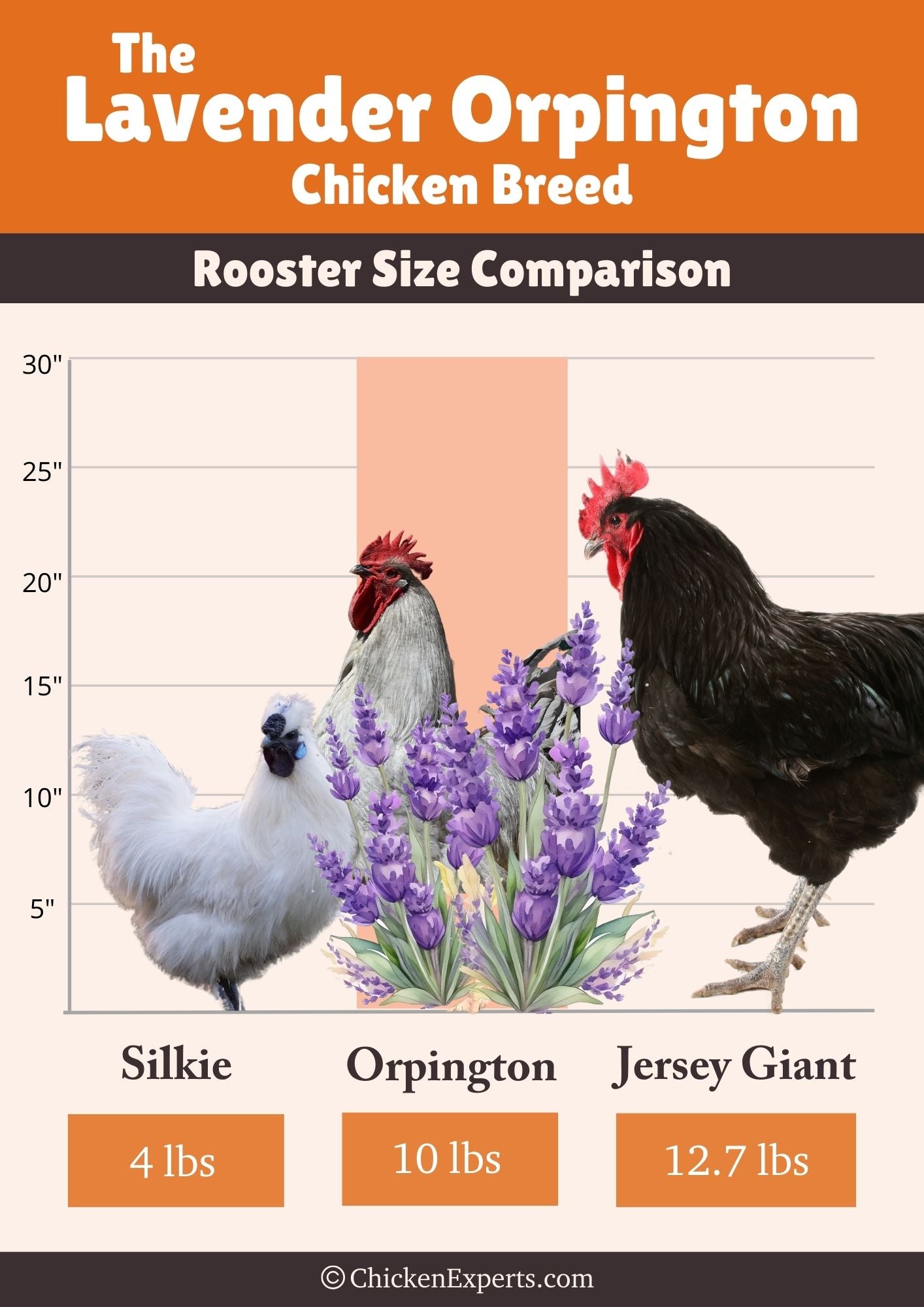
Why Are Lavender Orpingtons Rare?
Lavender Orpingtons are rare because breeding healthy chicks is so darn challenging.
The gene that produces the lavender color (lav) is recessive, which means that both Momma hen and Papa roo 🐓 must carry it for their chick to rock the purple rinse. Sounds simple enough? Well, the lavender gene is also linked to issues with weak feather development, so breeders need to constantly dilute the lavender gene and then breed it back in again to keep those lilac feathers looking lovely and functioning properly.
The Orpington breed as a whole has not long escaped the American Livestock Breed Conservatory’s endangered species list, and with lavender being the newest addition - and the most complex variety to breed - they’re understandably still rather rare out there!
Lavender Orpingtons are still possible to get hold of, thanks to the good old internet, but I wouldn’t trust anyone other than a reputable hatchery to master a healthy clutch.
Where Do Lavender Orpingtons Come From?
The Lavender Orpington chicken is the labor of love of Priscilla Middleton, a very highly respected UK breeder. She poured over these purple poultry for years in the 1990s, determined to fine-tune their lavender coloration.
Even in the UK Lavender Orpingtons are still ruffling the feathers of breeders, but they’re so pretty, so we’re happy to persist!
The first varieties of Orpington Chicken were also developed in the UK by William Cook in the 1800s.
What Are Lavender Orpington Chickens Like to keep?
Lavender Orpingtons are a pleasure to keep since they’re so hardy and easy to care for at the same time as being one of the most affectionate and friendly chicken breeds about.
Orpingtons are often referred to as the Labradors of chicken keeping. They’ll loyally bumble around after you just hoping for some of your time and attention…and treats.
These lovely chickens don’t just humor their humans, they actively enjoy our company. The feeling is mutual Orpingtons!
Are Lavender Orpington’s Beginner Friendly?
Lavender Orpingtons are perfect for beginner chicken keepers. Yep, they’re rare and unique and fancy and all that jazz, but since they’re also low maintenance and big softies meaning they make a brilliant beginners’ breed.
Healthy Lavender Orpingtons are suitable for beginners, but it’s super important to source these chicks from a reputable breeder since the feathering issues associated with poor bloodlines would be distressing to handle for even the most experienced keepers.
Are Lavender Orpingtons Like Other Orpingtons?
Other than their couture coloring and the impact that the recessive ‘lav’ gene can have on their feathering, Lavender Orpingtons share the same temperament, build, and productivity as all the other Orpington varieties.
Did You Know that excessive sunshine can damage your lavender chicken’s color? The lavender tint can fade to yellow in the sun. Make sure she has shade!
The Lavender Orpington Breed Standard
There are no specific variety standards for the Lavender Orpington since the color is still not officially recognized in the US or the UK. I doubt it will be long though since this lilac lovely is getting more and more popular. Rightly so! For showing these lilac lades all the Orpington breed standards still apply!
Varieties of Orpingtons
There are 12 known varieties of Orpington. The most common color is the Buff which is down to their popularity, and the rarest varieties are the lavender and the Spangled. There are also White, Birchen, Chocolate, Cuckoo, Gold Laced, Jubilee, Lemon Cuckoo, Partridge, and Red Orpingtons.
If you can’t find yourself a lavender Orpington, don’t discount the breed altogether. There are some absolutely stunning varieties that will happily cohabit for a perfect pick-n-mix poultry family.
Lavender Orpington Bantams
Lavender Orpington bantams are very rare gems in the US, but they need less of everything making lavender Orpingtons a possibility for chicken keepers with smaller backyards. They weigh in at just 34 – 38 ounces.
You will not be able to stop sharing photos of them! With all the plus points of a standard-sized Orpington and the added wow of watching a teeny lavender powder puff bumbling about after you, you’ll forgive them a slightly lower egg yield of just under 200 smaller eggs.
“The Bantam retains the appearance of the full-size bird, but in a smaller size. There is a large variety of colors in the Bantam version. The Bantam retains the friendly personality of the Standard breed, and are great for small backyards that want good little layers. Approx. 190 eggs per year.”(Sunset Valley Chicks)
Lavender Orpington Roosters
Lavender Orpington roosters are one of the friendliest roosters around. Just like any decent Daddy, they can be quite protective of their chicks and will defend their hens if they have to.
Since breeding lavender Orpingtons is not for the faint-hearted, not many backyard keepers house the roosters to breed.
Since lavender Orpington hens are more predictable than roosters most backyard keepers decide against keeping roosters unless they are looking for protection for free-range hens.
However, Lavender Orpington roosters prefer not to bother with drama if they can help it. Most are fairly docile and regular handling from a young age will help. Lavender Orpington roosters are friendly, for roosters, but they are still roosters!
What Do Lavender Orpington Chicks Look Like?
Lavender Orpington chicks 🐥 aren’t purple the moment they peep out of their eggs. Baby chicks have fluffy greyish and yellow feathers, with some lavender peeking through. Their beaks start off black.
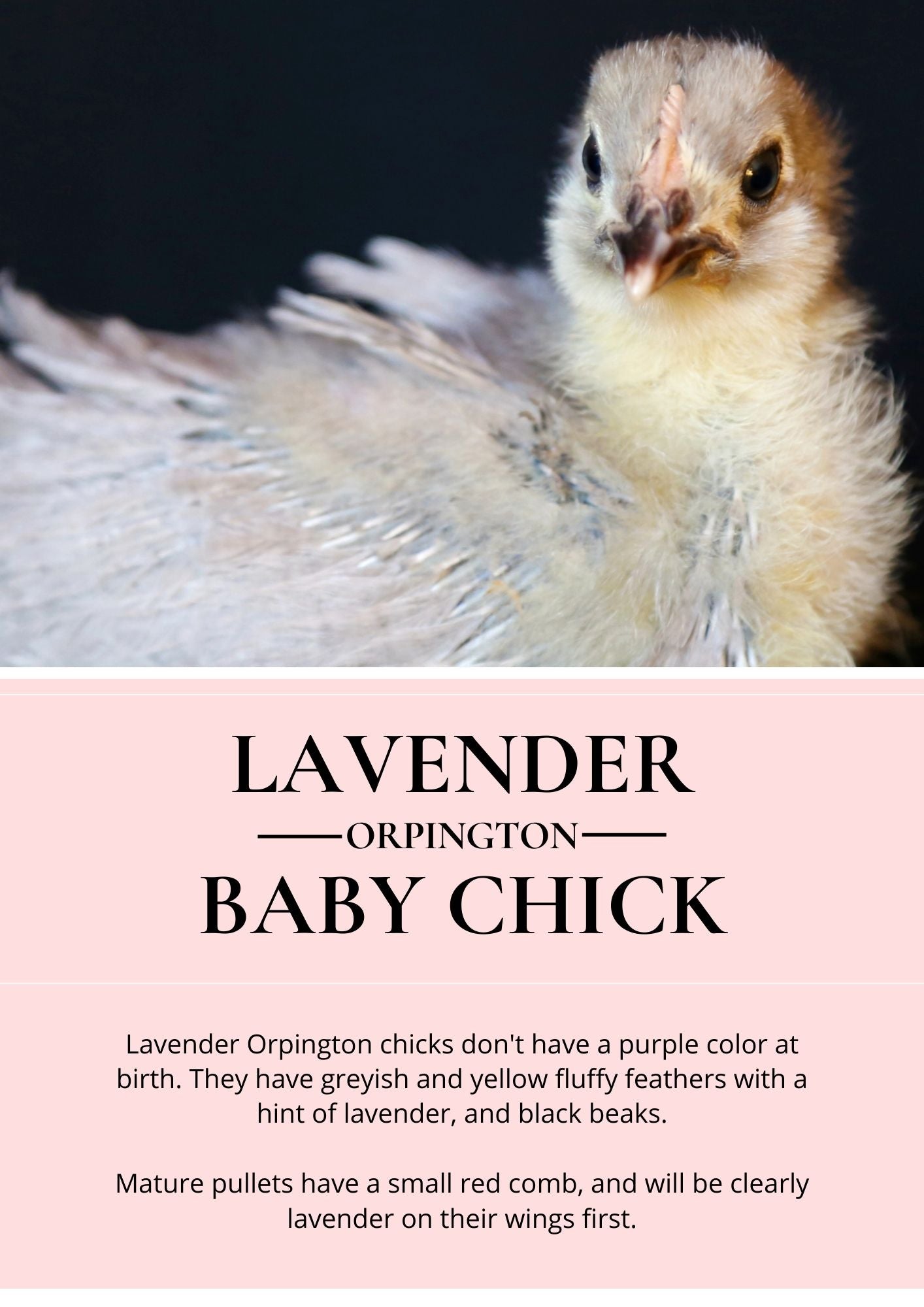
By the time pullets have reached maturity, they will be boasting their grown-up feathers, a tiny red comb, and will be clearly lavender on their wings first.
Lavender Orpington Hens vs Roosters
The best way to spot a male lavender Orpington chick from a female is that the males have longer tails and female chicks have shorter ones.
Both male and female chicks have faint white streaks near their upper wing joints, and females tend to have more lines on their backs. Sometimes females have a little brown beauty spot on the top of their heads.
Sexing your Lavender Orpingtons before they mature is mainly guesswork.
LAVENDER ORPINGTON EGGS
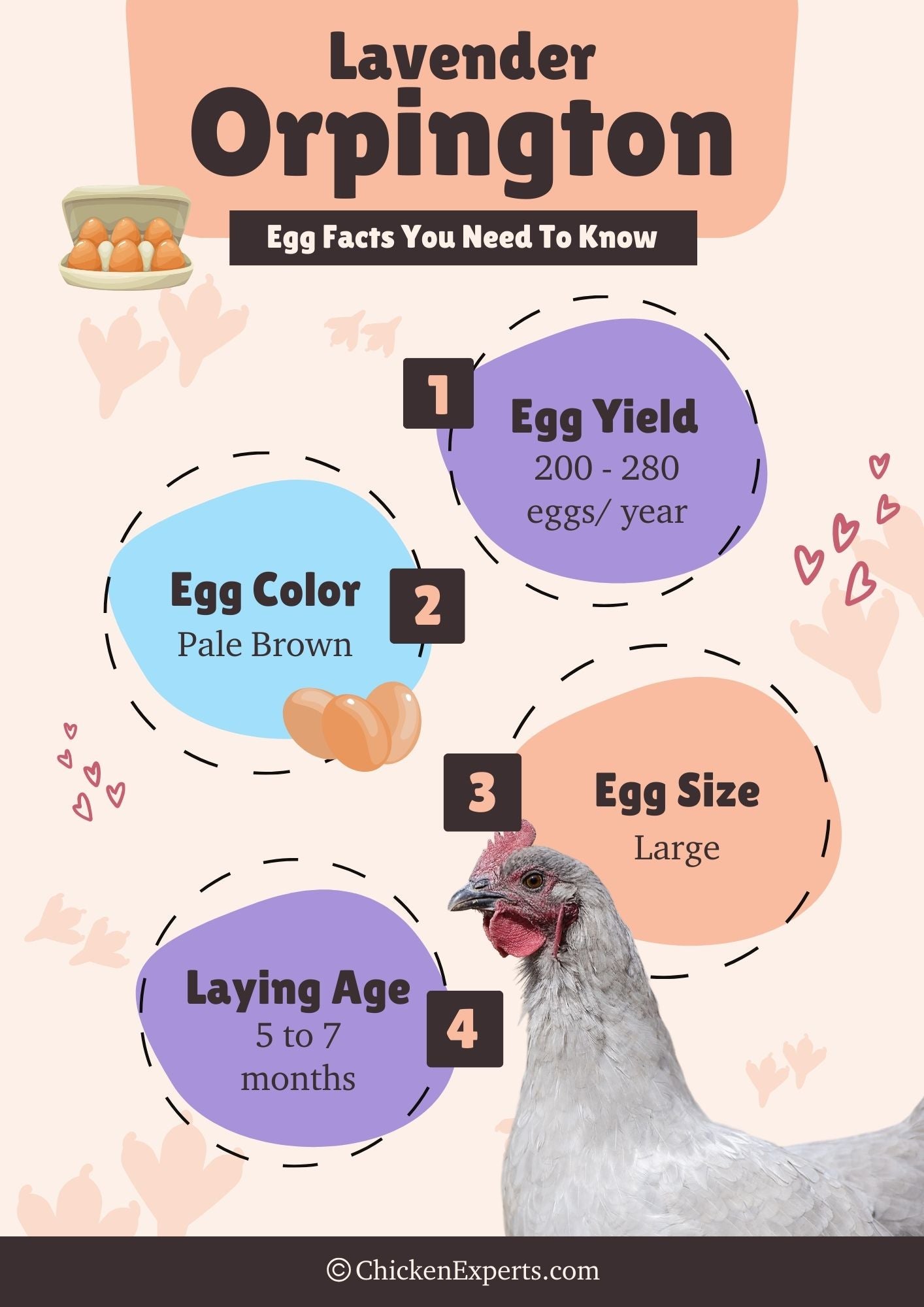
Do Lavender Orpingtons Lay Purple Eggs?
Lavender Orpington hens don’t lay purple, or lavender eggs. Their eggs are large in size and pale brown.
Which Chickens Lay Purple Eggs?
If purple eggs are what you’re after, then you need to ditch the idea that lavender chickens will lay them, or that any chicken will lay them. They don’t.
The English Croad Langshan is sometimes said to lay purple eggs, but it’s only an occasional tinge to the bloom.
“They are good layers, with good-size eggs ranging in color from light brown to a pinky color with a matt bloom like the bloom on a freshly-picked plum (which is why Croad Langshan eggs are often incorrectly described as plum-colored)
Marans sometimes lay burgundy tinted eggs, but again this is just a tint to the bloom, and calling them purple eggs is a bit of a push.
The Chilean Tinamou is a chicken-like, turkey-looking bird that lays amazing purple eggs. It’s not a chicken, but it’s worth a mention since its eggs are so shiny they look like they’re made of purple glass. They’re very cool!
How Many Eggs Do Lavender Orpington’s Lay?
Lavender Orpington hens will lay 3-4 eggs a week and 200 - 280 eggs a year. They’re ready to start laying eggs at around 5 to 7 months of age. Once they start, they rarely stop and lay three to four eggs a week.
Lavender Orpington hens will lay all year through since the cold doesn’t bother them, but beware of the broodiness!
Do Lavender Orpington Hens Go Broody?
Lavender Orpingtons go broody about least twice a year. They have a really strong maternal instinct, so when the hormones hit them you will have to battle for your eggs.
Whilst you might not want to face breeding this complex little creature, just like Silkies they make magnificent adoptive Mommas, so will happily sit on another hen's eggs if she needs a little help watching the kids.
KEEPING LAVENDER ORPINGTONS
Do Lavender Orpingtons Make Good Backyard Chickens?
Lavender Orpingtons make great backyard chickens since they are so easygoing! They’re laid back in their nature, fun, friendly, and amenable. They can be kept free range or in a well-sized chicken run.
Lavender Orpingtons are also healthy, cold hardy, and not very demanding. They’re quiet too, which is a bonus for keeping your neighbors happy and your family sane.
How Much Space Do Lavender Orpington Chickens Need?
Lavender Orpingtons kept in a run will need 8 to 10 square feet per bird to make sure they get enough exercise. They can be lazy, so they need the motivation to forage. They don’t fly, so smaller fences will keep them in, but not necessarily predators out.
In the coop, I’d allow 4-5 squared feet per hen since they can get quite hot in those fluffy jackets if they’re too cramped in warmer conditions.
Roost heights should be quite low so they don’t injure themselves hoping down and – since they’re a broad breed, I’d recommend at least 1.5 feet per chicken.
Are Lavender Orpingtons Cold Hardy?
Lavender Orpingtons prefer colder weather, so they’re perfect for cooler climates. They can handle warmer days too but can overheat so need lots of space, shade, and water.
Are Lavender Orpington Chickens Noisy?
Lavender Orpington chickens are one of the quietest breeds I can think of. They very rarely crow. They do chatter away, and you can hear them, sure, but they’re not loud in any way.
How Long Do Lavender Orpingtons Live For?
If you care for your flockwell then you can have them at your side for between 5 and 10 years.
Lavender Orpington Health Issues
Lavender Orpingtons are heavy chickens and are a bit on the lazy side. As a result, you’ll need to watch their waistlines. Obesity is the main health issue to be on the watch for with these otherwise hardy hens.
Lavender Orpingtons are prone to leg injuries because of their weight, so make sure their perches or coop entrances aren’t too high.
Breeding Lavender Orpingtons
Breeding lavender Orpingtons is tricky and best left to experienced – even expert – breeders. They are not the breed to begin with if you’ve never hatched your own clutch before.
In all lavender-colored chickens, the lavender gene is recessive, so both parents must carry the lavender gene to produce a baby Lavender Orpington. Once you’ve found two unrelated lavender carriers, they’ve only a 65-80% fertility rate (Cackle Hatchery)
Then, there’s a mutation associated with the lusted-after lavender gene that can cause abnormal feather development. It’s sometimes called the shredder gene or tail shredder gene. It means that barbs on the feathers don’t interlock, and feathers look like they’ve been through a paper shredder.
They look bad, but worse than that they don’t offer any insulation or function for the chicken.
“We also regularly cross back to black and the offspring from this cross are black but carry the lavender gene. Thus when crossed back to a pure lavender all offspring are lavender in color but with the improved characteristics of the blacks.” (Orpington Chickens UK)
Are Lavender Orpingtons Expensive?
Since Lavender Orpingtons are so rare, they cost a little more than other Orpingtons. You can expect to pay anywhere from $10 to $45 for a chick. Or $21.00 or $45.00 for a dozen hatching eggs. Males are cheaper because breeding at home isn’t often on the agenda.
Lavender Orpington Owners...Are You Out There?
Share your lovely lilac ladies' pics in the comments.
Lavender Orpingtons are undeniably rare and fancy chickens. If you’re drawn to them, it’s probably got something to do with their luscious lavender locks, but there are just so many stunning types of chicken and chicken breeds to pick from that I don’t want you to feel disappointed if you can’t locate a trustworthy breeder.
Whether you want a fancy chicken, a fluffy chicken, a friendly chicken, or it’s all about how many eggs they lay, pickin’ your chicken can feel overwhelming.
Understanding a breed’s needs and temperament is an absolute must before you make a final decision. Do you know how long chickens live for? This is a long-term commitment.
Chickenpedia’s chicken breed course is the best way to crack open the ins and outs of which chicken breeds will work for you. Their fun chicken breed course covers everything from personality, productivity, health issues, and broodiness, to how much room they need in their <coop>. Check it out!


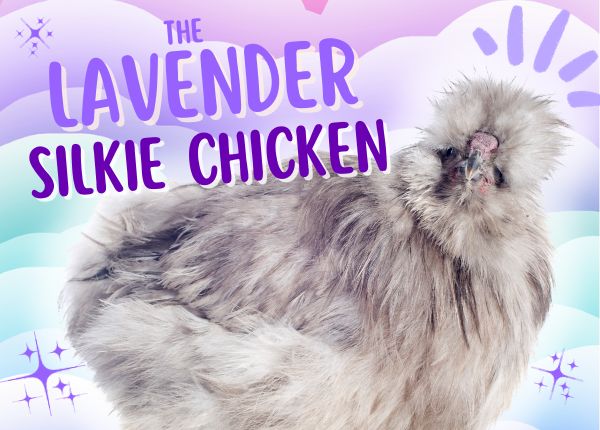
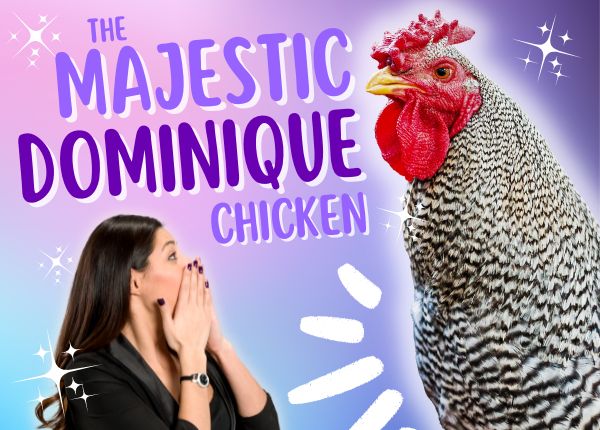



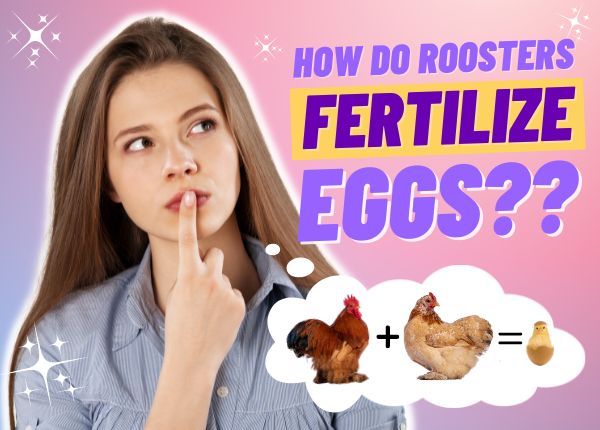



Leave a comment (all fields required)